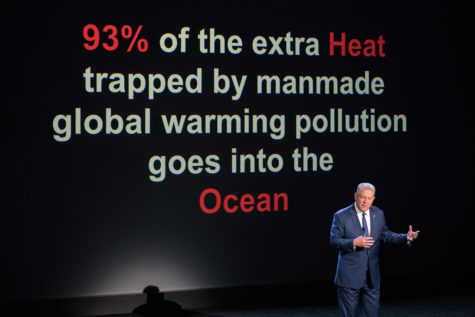“An Inconvenient Sequel: Truth to Power” makes poignant point during hurricane season
“An Inconvenient Sequel: Truth to Power” premiered at the 2017 Sundance Film Festival in January, following a documentary called “An Inconvenient Truth” that came out in 2006. Film directors Bonni Cohen and Jon Shenk took on the sequel to the original movie. Shenk was also the cinematographer of the movie. Cohen and Shenk are parents of Anabel Shenk, a student at the Urban School.
According to the website of the sequel, “A decade after ‘An Inconvenient Truth’ brought climate change into the heart of popular culture, comes the riveting and rousing follow-up that shows just how close we are to a real energy revolution.” The prequel was directed by Davis Guggenheim, focusing on “[giving] voice to a crisis that impacts us all: global warming”, according to the movie’s website. Although time has passed and progress has been made, climate change is still an important issue to address, and the movie’s aim is to galvanize the attention and support of the nation and world.
The sequel shows just how close the world is, and can continue to be, to a climate change revolution. As Al Gore travels the world, talking to world leaders as well as common citizens, he promotes the implementation of public renewable energy and emphasizes the risks of global warming. The movie continues up until President Donald Trump announced that the United States would withdraw from the Paris Climate Agreement. The agreement was signed at the United Nations on Earth Day in 2016, seeking to keep the global temperature rise below 2 degrees celsius during this century.
One of the main target audiences of the movie is young people. In a Question and Answer session following a San Francisco screening of the movie, Cohen stated that she and Shenk believe that “the film is a really good tool for kids to educate on behalf of schools, and family businesses and communities.” Young people are more likely to face the effects of climate change in their lifetimes, so it is imperative that students become aware and knowledgeable about climate change as they enter the world.
Devan Jeffrey (‘18), a student at The Urban School, said he did not know that much about Al Gore’s involvement with environmental issues before watching the movie, and “it was very inspiring and showed me how bad the situation really is.” Jeffrey said that he and his family are considering upgrading to PG&E renewable energy.
In the wake of Hurricane Harvey and Hurricane Irma, two hurricanes that struck the southern part of the United States at the end of the summer, the movie is incredibly relevant. Gore addresses the increase in tropical storms during the movie, including Typhoon Haiyan, a devastating storm that hit the Philippines in 2013. “The air is warmer and warming up these storms, the ocean air is warmer and coming in stronger… a storm equally bad was happening in Southeast Asia… these storms are going all over the world,” said Shenk when asked about the storms happening around the world today.
Even though the west coast does not face a high risk of tropical storms like hurricanes, that does not mean that people who live here will not feel the impact these storms have. “There is a human instinct to look for a safe place from the storm… but of course if you think about it, it doesn’t make much logical sense that there will be any place that isn’t affected by climate change. If these storms happen more and more on a regular basis, you can imagine the impact on our resources,” said Jon Shenk.
“All of our lives will be changed by this if we don’t act,” Shenk added, “I encourage people to think about the context in which we’ll be living rather than just your own personal safety.”


